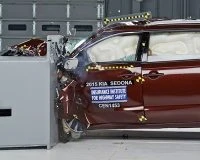
Since 1995, the Insurance Institute for Highway Safety has been testing automobiles for safety. This is done in an effort to promote safer vehicle manufacturing and consumer education on vehicle safety. The IIHS performs automobile safety testing in the Vehicle Research Center, located in Ruckersville, Virginia. Jones & Swanson will be posting a series of articles on the ins and outs of the IIHS Vehicle Research Center and safety testing procedures.
Our first article centers on the crash hall where vehicles are tested in engineered crash assessments, as well as the preparation performed on each vehicle prior to testing. The Vehicle Research Center has a 22,000 square foot crash hall that employs three different runways for various tests. Approximately 50-70 crash tests are performed yearly, with purposes of real vehicle testing to new technology testing. The propulsion system located beneath the floor of the crash hall allows vehicles to be accelerated during tests. Before these tests can begin, however, vehicles must be prepped accordingly.
When a vehicle arrives at the IIHS Vehicle Research Center, it is checked in and begins the process of crash test preparation. One of the first test preparation steps is to correctly position the vehicle seats. Standardized protocol is followed by using a device that represents a human occupant to determine exactly where the dummy should sit during the crash test. Next, measurements are taken of the vehicle’s structure so that intrusion can be measured after the crash. After that, the vehicle is turned over to the vehicle prep team to get the rest of the car ready for the test. Every vehicle that comes into the Institute is assigned a crash test number and a book that contains check off sheets. For everything that is done to this vehicle, the action is initialed and dated in the book. This book follows the vehicle all the way through the testing process. The first step that the prep team performs is a quick inspection of the vehicle to ensure that there is no previous damage. All fluids are then drained from the vehicle and gasoline is replaced with a solvent that is dyed purple. This solvent weighs the same as gasoline, but has a higher flash point, which allows leaks to be more easily detected. Power for onboard camera systems, data acquisition, and onboard braking unit boxes are installed in the vehicle next. Once these steps are complete, onboard cameras are installed and the vehicle receives stripes so that measurements can be taken more easily of how much the dummy, steering wheel, etc. moves during a crash. After all instrumentation is in place, the vehicle is weighed. This weight is put into the crash machine and used in the equation to ensure the speed is accurate. Finally, the vehicle is moved to the crash hall for cameras to be positioned.
Because a crash happens in a fraction of a second, it is much too fast for a person to grasp with the naked eye. In order to understand what’s really happening in a crash test, the action must be slowed down significantly. To do that, the IIHS uses sophisticated photographic equipment like special lights and high speed video cameras. These cameras allow the VRC to become more than a scientific laboratory. It is also a specialized production facility where footage and pictures are produced that engineers use in scientific analysis. These photos and videos are also use to communicate findings to the general public. The crash hall was designed with high-quality photography in mind. In some respects, it’s like a Hollywood sound stage with a very high ceiling and a grid that holds a custom built lighting array that produces 750 watts of soft diffused light. It is important that the light doesn’t cast hard shadows and reflections. It has to be very bright for the state of the art digital imager and slow motion cameras. These high tech cameras are completely file based, no film or tape, and they accept cinema quality lenses. They can record in extreme slow motion, which makes it possible for engineers to examine every detail of a crash. Because of the techniques that are used at the VRC, very high quality images are produced. In addition to slow motion cameras, real time cameras are used to convey a sense of how quickly a crash really happens and a still camera is used to produce a very high resolution image of the moment of maximum crush.
Each of these steps ensures accurate findings to be recorded so that makes and models can be compared to acceptable safety standards. For more information about each of the specific crash tests performed by the IIHS, visit www.iihs.org.
Categories: Auto Accidents, Car Accident, Personal Injury




